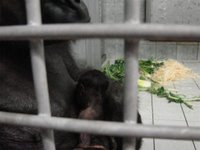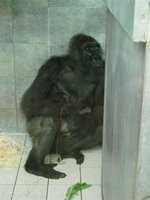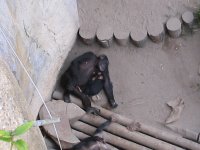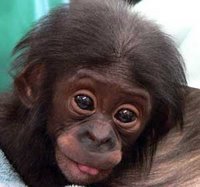Alex has had a tough time since I've been here due to conflicts in his group. First, he loses half a finger in a mysterious fight with the B-Chimp alpha, Unyoro. This past week more trauma occurred with the big guy, but this time a student here witnessed the fight.
Remember that Alex was nursery raised along with two unrelated females, Alexandra and Annet, who are 7 years old, about 2 years older than Alex. Although they are unrelated, these three are very close.


Alexandra and Annet are in fact nearly inseparable - they walk with their arms around each other most of the time. These three kids were integrated into a new chimp group (B) over a year ago joining 3 adolescent females (~13 yrs old) and the alpha male. And things were going quite well until this month.
In the latest incident, Unyoro started to harass Alexandra, probably to copulate but maybe just to dominate her. Young Alex tried to intervene so Unyoro attacked him instead, biting his hands and feet (a common attack strategy). The little guy survived but is now back in the nursery while he recovers. Alexandra was also hurt so she and Annet were also removed from the B-group. Early this week, Unyoro attacked Jahaga, one of the adolescent females, sending her to the nursery as well. I'm not sure what is going on with this dude and what strategy the zookeepers will follow. To some extent this is just the way of chimp life.
Despite the emotional impact of these attacks on human observers, Alex's actions pose some interesting questions. Why play the hero when he knew the risks of getting in the way? If Alexandra were at risk of death, and Alex were her biological brother, his actions would make sense from a kin selection point of view - protect your extended genetic interests. They are not siblings but he still may view her as a sister having been raised with her. Alex may also have misunderstood Unyoro's intentions as life-threatening to Alexandra when in fact he was probably trying to rape her. This sounds horrible, but "forced copulations" are a normal part of chimp life. And if this was at the heart of the incident, Alex broke the rules by trying to intercede. Unyoro would have viewed his intervention as an attempt to monopolize the female and hence a challenge to his alpha status.
We can find a selfish motive for Alex's actions by adding a series of misunderstandings to the cognitive processes at work, but this is by no means a secure conclusion. Other apes form coalitions to protect "friends" or kin. Usually these are subordinate adults who join together to defend against a dominant's attacks. The female gorillas here, however, intervened on behalf of an unfamiliar female that the zookeepers were trying to integrate into Gorgo's harem. In a 20 min film recording the integration, Gorgo bit and threw around the new lady, Effi, tearing her flesh in several areas.

Two other females jumped on Gorgo to prevent further attacks even though they had nothing to gain but his ire. We could interpret their seemingly altruistic actions in non-empathic terms. Perhaps, they found the racket annoying and wanted it to stop. But after incurring some injury to themselves, repeated assists seem more likely to have empathic underpinnings.


 The mother-child interactions are the most fun to watch. The kids just hang on while the mother moves around. The infants can walk early but are still very awkward with their limbs even after 2 years.
The mother-child interactions are the most fun to watch. The kids just hang on while the mother moves around. The infants can walk early but are still very awkward with their limbs even after 2 years.








